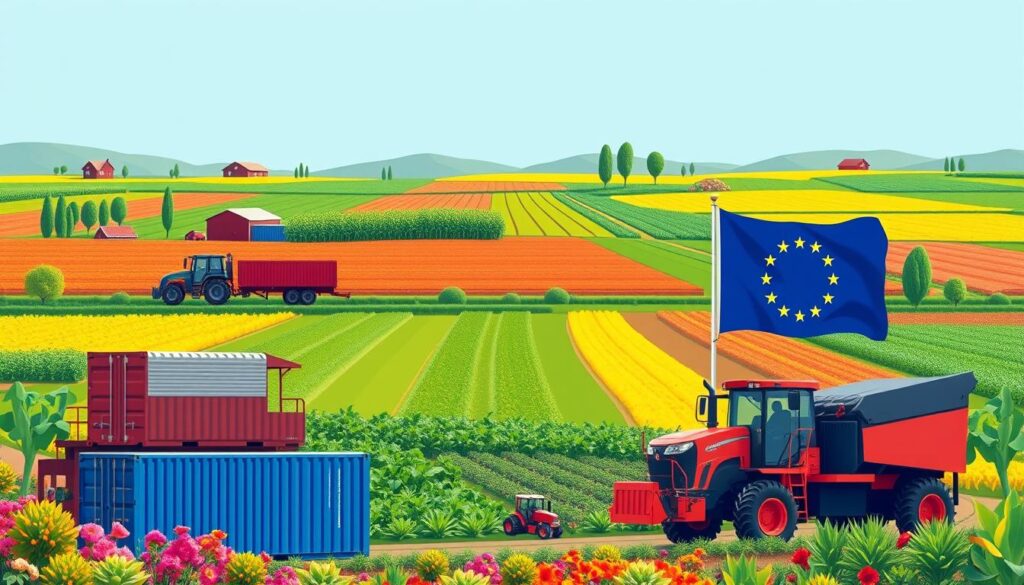When it comes to agricultural trade, the U.S. and the EU have had a relationship that can only be described as *cows and calves*—full of potential, yet often stunted by barriers, tariffs, and a hefty dash of regulatory red tape. Former U.S. Chief Agricultural Trade Negotiator, Gregg Doud, recently stood at the podium during the USDA’s 101st Annual Agricultural Outlook Forum, and if you thought barnyard stories were just for kids, think again! Doud unveiled the *grainy* realities and *cheddar* opportunities that lie ahead in U.S. agricultural trade with the European Union and beyond. Spoiler alert: it’s not all doom and gloom; it might just be time to raise a toast (or a *toast-ies*) to the future of our farmers.
In this article, we’ll explore the historical nuances of U.S. agricultural trade with the EU, peer into a crystal ball for emerging competitors like Brazil and China, and unravel how various trade agreements could pave the way for our farmers to hit a *bullseye* in exports. Ready to dig into the soil of opportunity and challenge? Let’s plow ahead—in a manner that’s both *a-maize-ing* and *un-be-leaf-able*! This isn’t just about trade; it’s about turning *corn-ventional* hurdles into *corn-ucopias* of opportunity!
Key Takeaways
- U.S. agricultural trade with the EU has been stagnant for decades, creating significant missed opportunities.
- The U.S. faces growing competition from countries like Brazil and challenges with exports to China due to their increased domestic production.
- There is a promising potential for expanding U.S. protein markets as global consumption increases in the next decade.
Historical Overview of U.S. Agricultural Trade with the EU
When it comes to agricultural trade between the U.S. and the EU, it seems we’ve been stuck in a long-standing relationship that’s more ‘Will they, won’t they?’ than a rom-com—namely because U.S. grain exports have been stagnating around the $10 to $12 billion mark for nearly 45 years. Former U.S. Chief Agricultural Trade Negotiator Gregg Doud recently had his grain silo full of insights at the USDA’s 101st Annual Agricultural Outlook Forum. Imagine him highlighting how we export more cheese to countries like Guatemala and New Zealand—talk about a ‘cheddar’ opportunity lost in the EU! With a staggering $23.6 billion trade deficit in agricultural products, Doud described our negotiation efforts as ‘impossible’. It’s like trying to win a debate in a room full of cows; you might get a moo or two, but not much more.
Doud didn’t just lay it all out in the pasture—he also discussed other key stakeholders in the ag market. With corn exports to China facing potential declines due to their agricultural advancements, and Brazil being the ‘double-cropping diva’ that it is, we’ve got competition. They’re not just growing crops; they’re doing it twice as fast! And don’t even get Doud started on India—his search for export opportunities there seems to be a bit of a drought.
However, all was not lost! Doud praised the Phase 1 trade agreement with Japan, calling it a golden egg laid by a trade chicken, thanks to its tariff reductions and expanded market access. The future is looking bright for U.S. protein markets—beef, pork, chicken, and dairy could all see a boost! Who knew the U.S. could soon become the rockstar of dinner tables worldwide? So, while we might need to work out some kinks in our ag trade with the EU, there is a ‘grape’ deal of potential lying in wait for us in the global market.
Global Competitors and Emerging Opportunities in Agricultural Markets
As Doud continued his address like a well-seasoned farmer with a bumper crop of wisdom, he painted a vivid picture of the global agricultural landscape, where many big players are tough nuts to crack—especially when it comes to securing trade deals. You see, contemplating China’s domestic corn production is a bit like trying to wrestle a pig in a mud pit; sure, you might make a splash, but the pig always seems to come out on top! And let’s not even get into Brazil, who’s providing us with plenty of unsolicited competition—this agricultural powerhouse is like a relentless overachiever in the school of crops, effortlessly doubling its output. On the other hand, searching for opportunities in India is like looking for a needle in a haystack—except this haystack is made of crops, and the needle is constantly moving away from trade negotiations. Yet, amid all these ups and downs, Doud’s words shone a light on the silver lining—particularly the astonishing possibilities that lie within the U.S. protein market. With global appetites increasing, our farmers could soon be serving up beef, pork, chicken, and dairy like they’re handing out samples at Costco! Just think of it: the U.S. as the live band at the world’s biggest barbecue—sounds delicious, right? Let’s just hope we can bag some solid deals and avoid those trade pitfalls, or we might find ourselves in a real pickle! But hey, if we take a cue from those competitive crops and hustle hard, we could soon be at the forefront of the ag trade scene. Remember folks, if there’s one thing that binds us, it’s that the future looks “grape” for U.S. agriculture!
Learn more about agriculture news by following us! And don’t forget to try Seaghetti now – sustainable food at its best.

